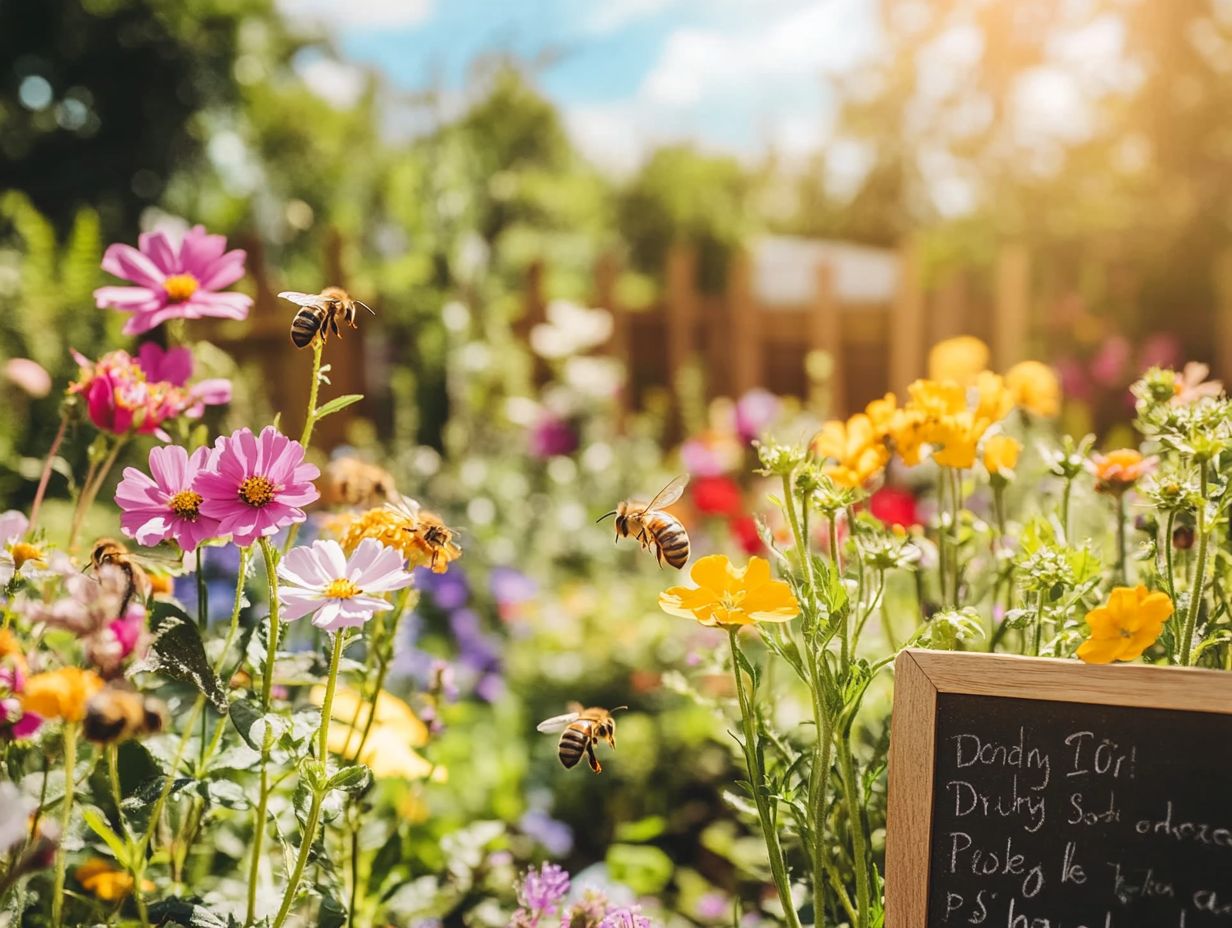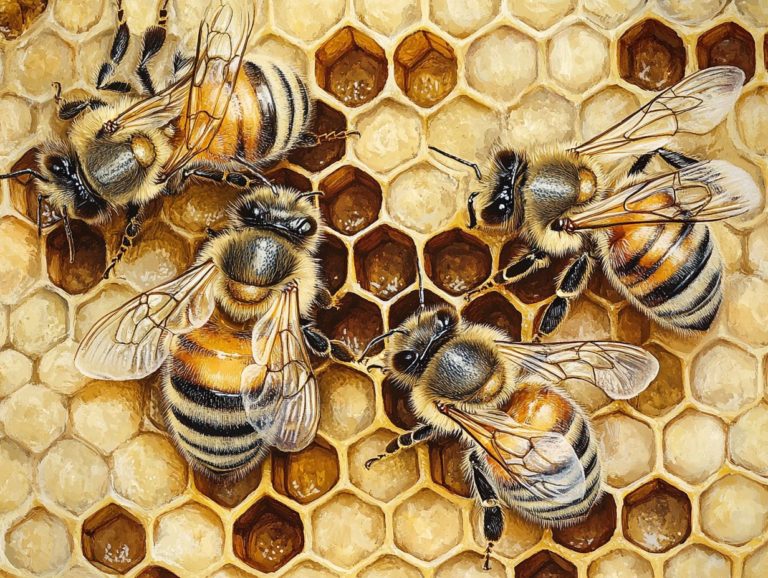5 Myths About Bees Debunked
Bees are frequently misunderstood, giving rise to myths that can obscure our appreciation for these essential creatures. Misconceptions regarding their behavior, along with the mistaken belief that all bees produce honey, can significantly influence how you perceive them.
This article sets the record straight by debunking five common myths about bees, delving into their diverse species and their critical roles in the environment, and exploring ways you can help protect them through ethical beekeeping practices and promoting backyard honey production.
Discover the truth behind these vital pollinators and learn how to contribute to their survival.
Contents
Key Takeaways:
1. Honeybees Die After They Sting
One of the most common myths you might encounter is the belief that honeybees die after they sting. This misconception stems from a misunderstanding of their biology and behavior. In reality, it s only honeybees (Apis mellifera) that exhibit this phenomenon. Their barbed stingers become embedded in the skin of their victim, leading to their untimely demise shortly thereafter. This instinctual defense mechanism is designed to protect their hive and the queen bee, ensuring the survival of the entire colony.
In contrast, bumblebees and solitary bees have smooth stingers that allow them to sting multiple times without harming themselves, showcasing a very different approach to defense. Understanding these anatomical differences is vital for grasping the important role honeybees play in our ecosystem. As essential pollinators, they significantly enhance agricultural productivity and contribute to the health of natural landscapes.
By dispelling myths about their behavior such as the incorrect idea that they die after stinging you can help foster a greater appreciation for these remarkable insects. Advocating for their protection is crucial, especially given the alarming declines in their populations due to pests and diseases like the Varroa mite. Their unique behaviors not only highlight the fascinating diversity within the bee family but also underscore the importance of conservation efforts and sustainable beekeeping practices.
2. All Bees Produce Honey
There’s a common misconception that all bee species produce honey. While honey bees are famous for their impressive honey production, many other bee species, such as bumble bees and solitary bees, either don t produce honey at all or create just a tiny bit for personal use rather than for storage in a hive.
Honey bees stand out not just for their ability to produce large quantities of honey but also for their complex social structure, which enhances their foraging and nectar collection efficiency. They depend heavily on nectar flow, which changes with the blooming of plants and the seasons, allowing them to gather resources cooperatively. In contrast, other bee species tend to forage alone, focusing on gathering pollen and a small amount of nectar to meet their immediate needs. Beekeepers monitor these cycles closely to ensure an optimal honey harvest.
Beyond honey, bee products like beeswax, propolis, and royal jelly play crucial roles in ecosystem health and agriculture. These industrious pollinators are essential for maintaining biodiversity and supporting food production systems, underscoring their remarkable importance in our world.
3. Bees Are Aggressive and Will Attack Humans
The common belief that bees are aggressive and will readily attack humans is often overstated. In reality, honey bees exhibit defensive behavior primarily when their hive is threatened. Understanding this difference helps us appreciate bee behavior and their crucial role within the ecosystem.
These remarkable insects prioritize the safety of their queen and colony above all else, as demonstrated by their coordinated responses to perceived threats. For instance, a honey bee will sting only when it senses danger to the hive, knowing that its stinger is a one-time defense mechanism that often leads to its own demise. This self-sacrificial instinct highlights their profound commitment to their community.
Hive inspections by beekeepers frequently involve careful handling to avoid triggering this defense mechanism.
To foster coexistence, understanding these behaviors can significantly alleviate fear. By remaining calm and avoiding sudden movements around bees, you can minimize the likelihood of provoking them. Educating others about this protective instinct not only helps dispel myths but also cultivates respect for these essential pollinators, which are vital to our ecosystem.
4. Bees Are Only Important for Pollination
While you may recognize that bees play a crucial role in pollination helping many plants and crops grow it s fascinating to discover that their significance transcends this function. They are vital in honey production and contribute immensely to the health of the ecosystem through their interactions with diverse bee species, each with a unique role in maintaining biodiversity.
These industrious insects do more than just produce honey; they create beeswax, propolis, and royal jelly, all of which are utilized in food, cosmetics, and pharmaceuticals. As you observe the intricate dance of bees as they flit between flowers, you witness the successful reproduction of various plant species, which in turn supports entire food webs that sustain a myriad of wildlife.
However, it s crucial to remain aware that bee populations are facing alarming declines due to habitat loss, pesticide use, and climate change. Factors like the spread of Colony Collapse Disorder a mysterious condition where bees leave their hives and do not return also contribute to these declines. The cascading effects of these declines pose a significant threat to global food security. Without these essential pollinators, the availability of many fruits, vegetables, and nuts could dwindle, highlighting the vital interconnectedness between bee health and ecosystem stability.
Join local initiatives to protect these vital pollinators and help preserve our ecosystem!
5. All Bees Are Black and Yellow

The common belief that all bees are simply black and yellow misses the remarkable variety among bee species. Take bumble bees, for example; they can showcase an astonishing range of colors and patterns. Then there are solitary bees, whose appearances can vary dramatically, showing us the rich tapestry of life that these essential pollinators represent within ecosystems. Some bees even exhibit metallic hues, adding to their visual diversity.
This diversity is not just about looks; some species are entirely black or boast striking metallic hues, while others flaunt vibrant blues, greens, or even intricate stripes. They come in a range of sizes, from the tiny inch-long sweat bees to the robust bumble bees, which can grow over an inch in length.
Habitat plays a vital role in their adaptability. Many bees thrive in urban gardens, parks, and meadows that coexist with natural environments like forests and wetlands. In these varied landscapes, bees have evolved specialized behaviors and physical traits that enhance their foraging efficiency and ensure successful pollination an essential process for both plant reproduction and the stability of ecosystems.
What Are the Different Types of Bees?
Understanding the different types of bees is crucial for keeping our environment healthy, as they each play a distinct role within it. Honey bees, bumble bees, and solitary bees each boast unique behaviors, appearances, and nesting habits.
This highlights their remarkable adaptations to diverse environments and their essential contributions to pollination and honey production.
Take honey bees, for example. They thrive in large colonies and are known for their honey-making prowess. They tirelessly transfer pollen from one flower to another, significantly boosting fruit and vegetable yields in agricultural settings.
Honey bees are also known for their honey production. Imagine a world without them what would our gardens look like?
Then there are bumble bees, with their sturdy bodies, perfectly equipped for pollinating plants that require buzz pollination a special way bumble bees vibrate to help flowers release pollen. They are essential players in the life cycle of many wildflowers.
And let s not overlook solitary bees. These fascinating creatures often nest in wood or soil, playing a vital role in pollinating a variety of crops while exhibiting intriguing behaviors, like tunneling to create individual nests. Each type of bee doesn t just support the flora around them; they also sustain diverse ecosystems, underscoring their significance in both nature and agriculture.
How Do Bees Benefit the Environment?
Bees play a crucial role in enhancing the environment through their pollination activities. Their work supports the growth of flowering plants, contributes to honey production, and maintains the biodiversity of ecosystems, ultimately ensuring food security for both humans and wildlife.
These industrious insects transfer pollen from one flower to another, performing a vital service for the fertilization and reproduction of many crops, including fruits and vegetables. This natural process boosts agricultural productivity, leading to increased yields, healthier plants, and superior-quality produce.
The interaction of bees with diverse flora not only benefits the agricultural sector but also reinforces the resilience of ecosystems, as a wide variety of plants depend on them for reproduction. Beekeepers often measure honey quality as an indicator of overall hive health and productivity.
However, the alarming decline in bee populations due to habitat loss, pesticide use, and climate change threatens this delicate balance. Act now to protect our pollinators, or we risk losing our food systems. This decline could lead to reduced pollination, dropping crop yields, and a subsequent loss of biodiversity.
The ripple effects of diminished bee activity underscore the critical importance of protecting these pollinators to preserve our food systems and maintain environmental integrity.
What Are the Common Misconceptions About Bees?
Many common misconceptions about bees, including myths regarding their behavior and the belief that they are inherently aggressive, contribute to unnecessary fear and misunderstanding of these essential pollinators. Addressing these myths is crucial for cultivating a deeper appreciation of bees and their vital role in our ecosystem.
For instance, you might think that all bees are aggressive and just itching to sting, but the reality is quite different. The majority of bee species are non-aggressive and primarily focused on foraging. Take the honeybee, for example it s often the star of the show. They will only sting if they feel their hive is threatened. Understanding their behavior and the ecological services they offer can significantly alter this perception.
By sharing stories of peaceful interactions with bees, such as observing a bumblebee gently pollinating flower after flower, you can help foster a mindset of respect and coexistence.
Scientific studies underscore the critical role bees play in agriculture and the environment, highlighting the necessity of public education to dispel common myths about beekeeping and nurture a more harmonious relationship with these essential inhabitants of our ecosystem. Let’s work together to protect and respect our buzzing friends!
How Can People Help Protect Bees?
Protecting bees is a collective endeavor, and you have a significant role to play. By creating bee-friendly habitats, supporting city beekeeping projects, and practicing ethical beekeeping techniques, you can prioritize the health and welfare of these vital colonies.
You can make a real difference by planting native flowers that provide essential nectar and pollen sources. Design gardens that bloom at various times throughout the year to support local bee populations. Steering clear of harmful pesticides is crucial. Instead, consider embracing natural pest control methods that won’t disrupt bee health.
Engaging with local beekeepers strengthens community ties and fosters sustainable practices and knowledge sharing. Education is key in cultivating a bee-conscious culture. Inspire yourself and others to advocate for conservation efforts and participate in workshops that highlight the importance of bees in our ecosystem.
What Are the Dangers of Declining Bee Populations?

The decline in bee populations presents significant dangers to agriculture and ecosystems. These essential pollinators play a crucial role in the reproduction of many plants. Their decrease can lead to reduced crop yields, disrupted food systems, and a loss of biodiversity. It’s imperative to understand the causes and consequences of these changes.
Several factors contribute to this alarming trend. The widespread use of harmful pesticides disrupts bee navigation and reproductive capabilities, making it challenging for them to thrive. Urban development and monoculture farming practices cause the loss of natural habitats, further compounding the issue and leaving these vital insects with fewer places to flourish.
Diseases like Colony Collapse Disorder have ravaged entire colonies, drastically diminishing bee populations. Without dedicated conservation efforts to address these challenges, the implications could be catastrophic not just for agricultural production but also for the natural ecosystems that rely on bees for pollination and ecological balance.
How Can We Encourage Bee-Friendly Practices?
Encouraging bee-friendly practices means you re not just spreading awareness; you re actively participating in initiatives that enhance the health and well-being of these vital pollinators. By supporting city beekeeping, embracing natural beekeeping methods, and creating environments where bees can thrive in both rural and urban areas, you play a crucial role in their survival.
Engaging in community gardens that prioritize planting nectar-rich flowers contributes to a local ecosystem that greatly improves bee foraging opportunities. Advocate for the use of native plants in landscaping; these species typically provide far superior resources for bees compared to their non-native counterparts.
You have the ability to transform urban spaces into sanctuaries for bees through thoughtful planning. Incorporating elements like green roofs, wildflower meadows, and pollinator pathways can create thriving habitats. These enhancements benefit bees and enrich biodiversity, elevate urban aesthetics, and foster a healthier environment for everyone in the community.
Frequently Asked Questions
Let’s bust some common myths about bees!
There are several myths surrounding bees, including misconceptions about their behavior and role in the environment.
Myth #1: All bees sting and are aggressive.
Not all bees sting, and only female bees have the ability to sting. Most bees are not aggressive and will only sting if they feel threatened.
Myth #2: Bees only produce honey.

While honey is a popular product of bees, they also play a crucial role in pollination and the production of other important foods such as fruits and vegetables.
Myth #3: Bees are pests and should be eradicated.
Bees are beneficial to the environment. They help plants reproduce and support our food supply.
Myth #4: Honey bees are the only type of bee.
There are more than 20,000 species of bees worldwide. Honey bees are just one type; solitary bees and bumblebees also play a crucial role in pollination.
Myth #5: Beekeeping is harmful to bees.
When managed properly, beekeeping can help bee populations. It provides safe and healthy habitats for bees to thrive.
Myth #6: Bees are not affected by pesticides.
Pesticides, especially neonicotinoids, can harm bees. Using bee-friendly alternatives and following application guidelines is vital to protect them.






